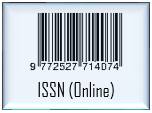OPTIMIZATION OF MIXING TEMPERATURE AND SONICATION DURATION IN LIPOSOME PREPARATION
(1) Faculty of Pharmacy, Sanata Dharma University, Yogyakarta
(2) Faculty of Pharmacy, Sanata Dharma University, Yogyakarta
(3) Faculty of Pharmacy, University Gadjah Mada, Yogyakarta, Indonesia
(4) Faculty of Pharmacy, University Gadjah Mada, Yogyakarta, Indonesia
(*) Corresponding Author
Abstract
Liposomes are a delivery system used in pharmaceutical products and cosmetics. Liposomes have many advantages such as increase stability and efficacy, can be targeted to reduce toxicity and increase accumulation at the target site and are biocompatible. Preparation of liposomes can be done by conventional or new methods which are still being developed. Conventional methods often require a long time and organic solvents which may be toxic. Heating (Mozafari method) is one of the new methods developed in the manufacture of liposomes without organic solvents. Mixing temperature can affect the physical properties of liposomes. The particle size has become one of the important physical properties because it affects the absorption of the drug. Sonication is an easy method of choice in reducing the size of liposomes. Optimization of mixing temperature and duration of sonication in liposomes preparation using new heating methods and sonication were performed by factorial design with 2 factors and 3-levels to obtain optimal liposome size. Data were analyzed with two-way ANOVA. The results showed that both mixing temperature and sonication duration significantly affect liposome size, but the interaction was not statistically significant. Data analysis also showed that mixing temperature, sonication, and their interaction do not affect the polydispersity index of liposome. Results showed the optimum mixing temperature and sonication duration that can produce liposomes with size below 100 nm is at 60C for 30 minutes.
Keywords
Full Text:
PDFReferences
Akbarzadeh, A., Sadabady, R., Davaran, S., Joo, S., Zarghami, N., Hanifehpour, Y., Samiei, M., Kouhi, M., Koshki, K., 2013. Liposome?: Classification, Preparation, and Applications. Nanoscale Res. Lett., 8, 19.
Badran, M., 2014. Formulation and In Vitro Evaluation of Flufenamic Acid Loaded Deformable Liposome for Improved Skin Delivery. Dig. J. Nanomater. Biostruct., 9, 8391.
Barenholz, Y., 2001. Liposome Application: Problems and Prospects. Curr. Opin. Colloid Interface Sci., 6, 6677.
Colas, J.C., Shi, W., Rao, V.S.N.M., Omri, A., Mozafari, M.R., Singh, H., 2007. Microscopical Investigations of Nisin-Loaded Nanoliposomes Prepared by Mozafari Method and Their Bacterial Targeting. Micron, 38, 841847.
Dwiastuti, R., Noegrohati, S., Istyastono, E.P., Marchaban, M., 2016. Metode Pemanasan dan Sonikasi Menghasilkan Nanoliposom dari Fosfolipid Lesitin Kedelai (Soy Lecithin). J. Pharm. Sci. Community., 13, 2327.
Eloy, J.O., de Souza, M.C., Petrilli, R., Barcellos, J.P.A., Lee, R.J., Marchetti, J.M., 2014. Liposomes as Carriers of Hydrophilic Small Molecule Drugs: Strategies to Enhance Encapsulation and Delivery. Colloids Surf. B Biointerfaces., 123, 345363.
Jahadi, M., Khosravi-Darani, K., Ehsani, M.R., Mozafari, M.R., Saboury, A.A., Seydahmadian, F., Vafabakhsh, Z., 2012. Evaluating the Effects of Process Variables on Protease-Loaded Nano-Liposome Production by Plackett-Burman Design for Utilizing in Cheese Ripening Acceleration. Asian J. Chem., 24, 38913894.
Jufri, M., 2004. Arah dan Perkembangan Liposome Drugs Delivery System. Maj. Ilmu Kefarmasian., 1, 5968.
Kang, K.C., Lee, C.I., Pyo, H.B., Jeong, N.H., 2005. Preparation and Characterization of Nano-Liposomes using Phosphatidylcholine. J. Ind. Eng. Chem., 11, 847851.
Knight, C., 1981. Liposomes: From Physical Structure to Therapeutic Applications.
Lasic, D.D., 1988. The Mechanism of Vesicle Formation. Biochem. J., 256, 1.
Machado, A.R., Assis, L.M., Machado, M.I.R., Souza-Soares, L.A., 2014. Importance of Lecithin for Encapsulation Processes. Afr. J. Food Sci., 8, 176183.
Mozafari, M.R., 2010. Liposomes : Methods and Protocols.
Mozafari, M.R., 2005. Nanoliposomes: From Fundamentals to Recent Developments. Trafford Publishing.
Shashi, K., Satinder, K., Bharat, Prashar, 2012. A Complete Review on: Liposome. Int. Res. J. Pharm., 3, 1016.
Winterhalter, M., Lasic, D.D., 1993. Liposome Stability and Formation: Experimental Parameters and Theories on the Size Distribution. Chem. Phys. Lipids., 64, 3543.
DOI: https://doi.org/10.24071/jpsc.00728
Refbacks
- There are currently no refbacks.
Copyright (c) 2017 Journal of Pharmaceutical Sciences and Community
Jurnal Farmasi Sains dan Komunitas (Journal of Pharmaceutical Sciences and Community)
Published by Faculty of Pharmacy, Universitas Sanata Dharma Yogyakarta

This work is licensed under a Creative Commons Attribution 4.0 International License.













.png)













